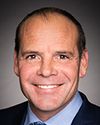Thank you, Mr. Chair and members of the committee. It is great to be here.
Amtrak was created by the U.S. Congress in 1970. The company is operated and managed as a private corporation, with the federal government owning a controlling interest. By law, our mission is to “provide...efficient and effective intercity passenger rail mobility, consisting of...high-quality service that is trip-time competitive with other intercity travel options.”
In fiscal year 2023, we served more than 40 routes, operating almost 300 trains a day, and the Amtrak workforce delivered 29 million passengers to 524 stations in the U.S. and Canada. We expect our fiscal year 2024 ridership to match or exceed our prepandemic levels of 32.5 million passengers, and by 2040, we hope to be serving 66 million customers a year. Those are 66 million trips that won’t strain already congested highways and airlines. It means travel time for those passengers will be usable and productive.
Our intercity service takes three forms.
The northeast corridor service line provides fast, frequent service at speeds of up to 150 miles per hour along a mostly Amtrak-owned line. We share it with commuter and freight trains between Boston and Washington, D.C. While ticket revenues significantly exceed operating costs, the federal government and state governments fund most of the capital projects along that service.
The long-distance line provides daily and, in two cases, three times a week service along routes that are at least 750 miles in length. It depends on annual federal appropriations for operation.
The third type of service is the state-supported service line, which provides service along shorter corridor routes outside of the northeast corridor, pursuant to contracts with the relevant states. The states partner with Amtrak to provide funding for their service and determine daily frequency and other operational attributions.
Both the state-supported and long-distance trains typically operate over tracks owned by other railroads. We call them host railroads. Federal law guarantees Amtrak access to the host railroads’ infrastructure for compensation, based on an incremental cost, and requires that Amtrak trains receive preference in dispatch over freight trains.
We believe that important and expanded state-supported service throughout the U.S. and Canada is key to our long-term growth. Some of our state-supported services have similar characteristics to Canada’s planned high-frequency service. Several have 10 or more round trips a day. A few operate over rail lines used almost exclusively by passenger rail. On several routes, trains operate at speeds of 110 miles per hour.
Our state-supported routes, like the Amtrak Cascades from Eugene, Oregon to Vancouver, British Columbia, the Chicago to St. Louis Lincoln service in the Midwest, and the Virginia service in the southeast continue to make investments over time, which have caused frequency, reliability and quality of service to improve over time.
Consider the state-supported service in Virginia, which began in 2009 with funding for a single daily round trip. Today, Virginia supports eight daily round trips between Washington, D.C. and various end points of the state. As frequency was added, ridership grew. Ten years ago, the Virginia service carried fewer than 900,000 passengers a year, whereas last year the same service carried 1,300,000 travellers, a remarkable 48% increase following that investment. This growth in ridership helped build support for “Transforming Rail in Virginia”, a state-led initiative that provides for five additional round trips per day by 2030, as well as increased reliability, greater convenience and improved customer experience.
Of course, the northeast corridor illustrates the value of high-frequency service even more clearly. Together, Amtrak’s high-speed Acela trains and its conventional northeast regional trains deliver hourly or better service during peak periods. Both routes are operationally profitable, and their combined ridership last year exceeded 12 million passengers, more than 40% of Amtrak’s system-wide total.
We greatly value the partnership with Canada. We look forward to continuing to work closely with the Canadian government and other stakeholders, especially with our partner, Via Rail, on issues like expanding pre-clearance, which will improve cross-border service. We would be delighted to see even more intercity passenger rail between our two countries, like the proposed connecting service between Detroit and Windsor.
Thank you for the opportunity to present to the committee. I look forward to your questions.




